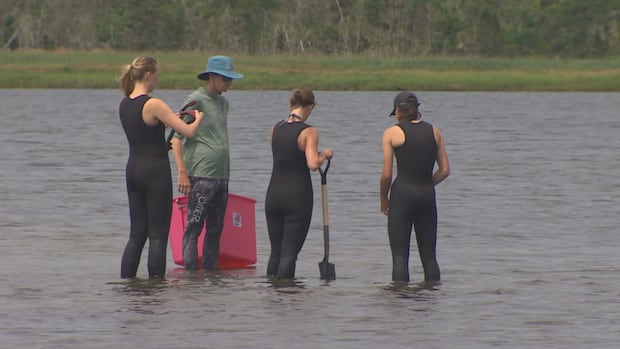Groups conducting coastal restoration work in Nova Scotia say provincial regulations are posing almost insurmountable barriers, forcing them to cancel projects meant to support healthy ecosystems.The Community Eelgrass Restoration Initiative conducts eelgrass research and replanting at different coastal sites in Nova Scotia, working with Dalhousie University and the Confederacy of Mainland Mi’kmaq.But lead scientist Kristina Boerder said permitting requirements from the province’s Department of Natural Resources have been difficult to meet. “The amount of red tape that’s being given to us has been astonishing, especially in light of seeing a lot of big corporate projects currently just being waved through,” said Boerder.Organizations conducting work on coastal erosion and shoreline cleanups are encountering similar issues, prompting advocates to say the province needs a new approach to permitting with restoration projects. The group is using different methods of planting eelgrass to see which is most effective. (Dave Laughlin/CBC)”That’s a huge issue, and something that really needs to be resolved,” said Simon Ryder-Burbidge, senior marine campaign co-ordinator with the Ecology Action Centre.”[There’s} a lack of focus at the provincial level so far in creating space and opportunity for these projects to go forward, even though we’ve heard from a number of important stakeholders out there who are interested in doing these things.”‘We’re not taking anything — we’re restoring’Since 2023, the Community Eelgrass Restoration Initiative has been working to map and restore eelgrass at locations across the province. Eelgrass provides vital habitat for a range of species, including lobster, juvenile herring and flounder. It also protects shorelines against erosions, keeps the water clear, and captures carbon. “Eelgrass is one of these unsung heroes that actually gives us a lot of benefits,” said Boerder.Over time, many of the eelgrass meadows that once rippled along Nova Scotia’s coastlines have disappeared. In trying to bring those back — which involves planting blades of eelgrass on the ocean floor in shallow water — the group has had to get permits from the Department of Natural Resources to work in what is considered submerged Crown land.Kristina Boerder, lead scientist with the Community Eelgrass Restoration Initiative, says permitting requirements are making it challenging to move ahead with eelgrass restoration in the province. (Adam Inniss/CBC)”We thought, this is a community-led project … and it’s a project that benefits everybody, that this would be a fairly low-hanging fruit to get these permits, because we’re not taking anything — we’re restoring.”Instead, the group has consistently run into obstacles. First, Boerder said they faced the same permitting requirements as aquaculture projects or wharf building, and that the department was slow to issue permits.This year, Boerder said the department began insisting they respect riparian rights, which prevent anyone from obstructing a coastal property owner’s access to the water. Boerder said they were told the group had to have permission of coastal property owners to be active on submerged Crown land in front of their properties.”No one can really find out where this legislation stems from, where it’s rooted, and how it applies,” Boerder said.”The application on our work doesn’t really seem to fit, because neither are we obstructing anybody, nor are we building permanent structures — this is a naturally occurring ecosystem that is even in the interest of the landowner.”Because some properties were owned by numbered companies with no contact details, this has sometimes left the group no way to reach out for permission. Already this year, they had to change or abandon plans at two sites, because the nearby land was owned by “cryptic holding firms.””If we have to do [this], it will sink all our future restoration work,” said Boerder. “We wouldn’t even touch the land. We would come in by boat. We are below the low-water mark.”In a statement, the Department of Natural Resources said it is supportive of eelgrass restoration, but also makes sure “proper precautions are taken when this activity is done on Crown land that we manage on behalf and for the benefit of all Nova Scotians.”The statement read that when the activity takes place in front of privately owned property, they want property owners to be aware, and require proof the proponents have contacted owners.Permit requirement also applies on reservePermitting issues have also affected projects taking place on reserve land.Tyler Sack, with the Confederacy of Mainland Mi’kmaq, said last summer, communities prepared for eelgrass replanting along the shoreline, only to find out on the day of an event that even on reserve lands, the site was considered submerged Crown land, requiring permits.”We’re not introducing non-native species, and we’re not even working in lands that don’t already have eelgrass growing,” he said.”To me, it’s a pretty low-risk initiative that the community has expressed a desire to see move forward, and we’re hitting these obstacles with permits when according to every treaty and piece of legislation outlining Indigenous rights, we should have that authority within the community.”While they’ve been able to secure permits since then, Sack said he fears the problem will come up again in the future.”I don’t think the problem has been solved where we won’t run into the same obstacles moving forward, especially with different initiatives looking at restoring different species or working with different communities.”Angela Riley now has hundreds of volunteers on her Scotian Shores team, who clean beaches across the province daily. (Robert Guertin/CBC)Other groups working on the shoreline are also encountering difficulties. Angela Riley, founder of the shoreline cleanup group Scotian Shores, said the bulk of her job is applying for permits, rather than picking up debris.”It’s so frustrating to be met with so much red tape when we’re the ones that are really understanding what we’re protecting and … trying to protect it.”Riley said species-at-risk requirements have led to her small team being denied a permit to remove a herring net from a beach because of piping plover nesting season. All this means regulations that are meant to prevent damage end up exacerbating it, Riley said. “The reason why some of these habitats are as polluted as they are is because of the permitting that’s required to clean them,” she said. “I can name many beaches that are covered in lobster traps that are piping plover critical habitat, but I’m not allowed to clean them up.”In its statement, the Department of Natural Resources said a permit is not required to walk on a beach and do a shoreline cleanup, but a permit is required when a vehicle is involved.While permits may have restrictions on times of year because of species at risk, “it does not prevent this good work from being done and it’s necessary to ensure there are no unintended consequences,” the statement read.Eelgrass stores carbon and methane in its root system. (Adam Inniss/CBC)Advocates with the Ecology Action Centre, which has also partnered on eelgrass restoration projects, say these issues show why a process to support restorative projects is important. Nicholas Winkler said the coastline is a complicated area involving multiple levels of government.But because restoration work is a relatively new area, this creates additional complications when working with regulations not designed for this kind of activity. “Most of the permitting structures that we are dealing with in this context are actually not made for what we’re doing, at all,” Winkler said.”Now that people understand the importance of protecting the coast … we do need a kind of fit-for-purpose regulatory structure that is going to allow us to do the kind of restoration work that’s needed at scale to actually make a meaningful impact.”Riley says permits for shoreline cleanup work can be slow to arrive. For one beach, permitting issues mean they won’t be able to go back until a year after they started their initial cleanup. (Submitted by Angela Riley)As for the work that The Community Eelgrass Restoration Initiative is doing, Boerder said while the individual staff they’re working with at the Department of Natural Resources have been helpful, the issue seems to come from higher up. The group’s request for a conversation with the minister’s office has gone unanswered.At a time when the provincial government is publicly expressing a commitment to streamlining permitting for other kinds of projects, like mining, Boerder said it’s frustrating to be facing barriers for restoration. “It very much seems like we’re having a double standard here, of who gets to do what and why,” she said.”I think this is an ideal opportunity where brownie points can be gained to a certain degree, because making this easier for these kinds of projects, who work for the greater good … there’s no downside.”
Groups conducting coastal restoration in N.S. say they face ‘astonishing’ red tape











